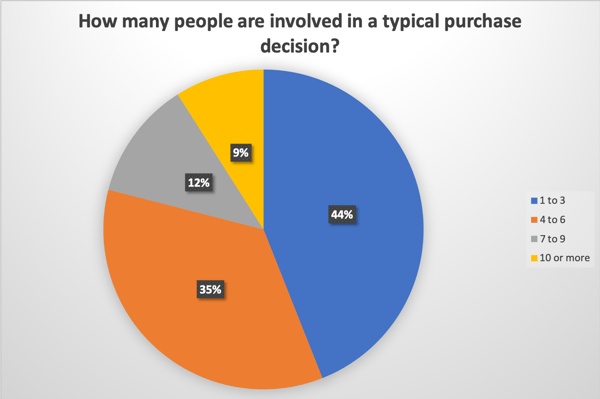
Sales enablement, as defined by HubSpot, is the the processes, content and technology that empower sales teams to sell efficiently at a higher velocity.
Put more simply, sales enablement is a recognition that the B2B buying process has changed. Buyers buy based on their needs and processes, the role of sellers is to understand those needs and processes and to facilitate the buying process. In order to be successful in the modern sales paradigm, you first need to understand how your buyers buy.
DemandGen Reports recently released 2019 B2B Buyer Behavior Survey Report gives great insight into how buyers are buying today. While many trends have continued from previous years, there have been some significant changes in buyer behavior this year that should inform your business development strategy.
Buying committees continue to be the standard in B2B purchases
It's no longer enough to sell to the decision-maker or economic buyer. Typical roles in the B2B purchase process included:
-
- Decision-maker (controls the budget for the purchase decision)
- Coach (internal influencer that supports your solution)
- Technical buying influencer
- Researcher
- End user (person or people that will use your solution)
65% of B2B buyers surveyed in the DemandGen Report said they have formal buying committees in place to evaluate potential purchases. Here's a summary of the number of people involved in the typical sales process.

What should you do to thrive in the purchase by committee paradigm? Here are a few suggestions.
-
- Document the typical purchase process in your target market. Talk to satisfied customers and find out how they purchased your solution. Who was involved in the decision? What role did each person play?
- Make the identification of the people involved and the purchase process a milestone in your sales process. Don't move to the next step in your sales process until you know who will be involved and how the decision will be made. If a prospect isn't willing to share this information with you, you're not on solid footing to move forward.
- Create content that satisfies the needs of each role in the purchase process. The needs of the economic buyer and the end user are very different, but both generally need to be on board with purchasing your solution. Create content that addresses their unique needs and questions.
Buying processes are getting longer, but........
The report confirmed that purchase cycles are getting longer - 57% of buyers said their purchase cycles lengthened when compared to the previous year.
But there's a caveat - 42% said they engaged with reps from the winning vendor in the first month of the purchase cycle. This evidences the value of engaging early with potential customers to understand and influence the purchase process. This sales outreach isn't random dialing for dollars - it's strategically responding to potential buying signals like a content download or webinar attendance.
That's it why it's important to have a qualification process in your lead generation that quickly identifies potential customers. When you identify a sales qualified lead, initiate a consultative outreach to engage prospects. Remember, this is not the time to sell. It is the time to educate both yourself and the prospect. When you get involved early with a prospect, you should ask questions to help understand their needs and how they move through their purchase process.
Another interesting finding of the report is that 83% of B2B buyers said that they "often accelerate or put purchase decisions on hold based on changing business needs and/or priorities." If you're engaged with your prospect, you know why and when the process is stalling or accelerating.
You will only earn the opportunity to be trusted early in the process by helping your prospects and adding value.
Advertising and websites play a key role in engaging buyers
68% of buyers said that they noticed ads from the winning vendor during the purchase process. 37% said that the ads positively impacted their view of the company. While Adwords, social media ads and retargeting campaigns may not close deals in the B2B sales process, they definitely play a role in creating awareness with buyers.
Buyers also indicated the importance of your website as they conduct research and start narrowing down their list of potential vendors.
-
- "97% said that it was important to them that vendor websites have relevant content that spoke directly to their company."
- "97% said that it was important to them that vendor websites offered easy access to content (i.e. no gates or minimal gates)."
- "96% said that it was important to them that the vendor websites spoke directly to the needs of their industry and demonstrated expertise in their area."
Regardless of how you initially engage with a potential customer, they will inevitably come to your website. Your website can either improve your chances of closing the deal or diminish them. Make sure your website has a good user experience, is easy to navigate and has content that educates and engages buyers.
Knowing how your buyers buy and what's important to the them is the first step in optimizing your business development process. The idea of sales enablement is to remove impediments and make it easy for your target market to buy from you. If you'd like some advice on how to optimize your business development, schedule a no-obligation consultation with us.







